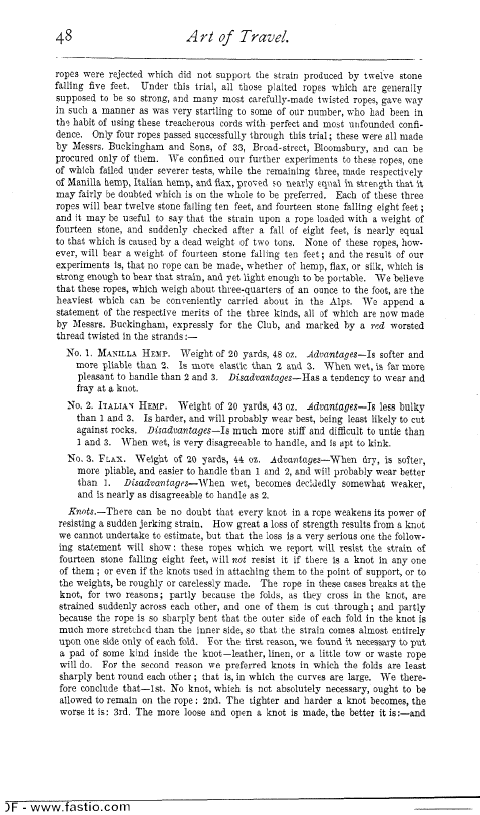| ||||||

OCR Rendition - approximate48 Art of Travel. ropes were rejected which did not support the strain produced by twelve stone falling five feet. Under this trial, all those plaited ropes which are generally supposed to be so strong, and many most carefully-made twisted ropes, gave way in such a manner as was very startling to some of our number, who had been in the habit of using these treacherous cords with perfect and most unfounded confidence. Only four ropes passed successfully through this trial; these were all made by Messrs. Buckingham and Sons, of 33, Broad-street, Bloomsbury, and can be procured only of them. We confined our further experiments to these ropes, one of which failed under severer tests, while the remaining three, made respectively of Manilla hemp, Italian hemp, and flax, proved so nearly equal in strength that it may fairly be doubted which is on the whole to be preferred. Each of these three ropes will bear twelve stone falling ten feet, and fourteen stone falling eight feet ; and it may be useful to say that the strain upon a rope loaded with a weight of fourteen stone, and suddenly checked after a fall of eight feet, is nearly equal to that which is caused by a dead weight of two tons. None of these ropes, however, wilt bear a weight of fourteen stone falling ten feet; and the result of our experiments is, that no rope can be made, whether of hemp, flax, or silk, which is strong enough to bear that strain, and yet light enough to be portable. We believe that these ropes, which weigh about three-quarters of an ounce to the foot, are the heaviest which can be conveniently carried about in the Alps. We append a statement of the respective merits of the three kinds, all of which are now made by Messrs. Buckingham, expressly for the Club, and marked by a red worsted thread twisted in the strands: No. 1. MANILLA HEMP. Weight of 20 yards, 48 oz. Advantages-Is softer and more pliable than 2. Is more elastic than 2 and 3. When wet, is far more pleasant to handle than 2 and 3. Disadvantages-Has a tendency to wear and fray at a knot. No. 2. ITALIAN HEMP. Weight of 20 yards, 43 02. Advantages-Is less bulky than 1 and 3. Is harder, and will probably wear best, being least likely to cut against rocks. Disadvantages-Is much more stiff and difficult to untie than I and 3. When wet, is very disagreeable to handle, and is apt to kink. No. 3. FLAX. Weight of 20 yards, 44 oz. Advantages-When dry, is softer, more pliable, and easier to handle than 1 and 2, and will probably wear better than 1. Disadvantages-When wet, becomes decidedly somewhat weaker, and is nearly as disagreeable to handle as 2. Knots.-There can be no doubt that every knot in a rope weakens its power of resisting a sudden jerking strain. How great a loss of strength results from a knot we cannot undertake to estimate, but that the loss is a very serious one the following statement will show : these ropes which we report will resist the strain of fourteen stone falling eight feet, will not resist it if there is a knot in any one of them ; or even if the knots used in attaching them to the point of support, or to the weights, be roughly or carelessly made. The rope in these cases breaks at the knot, for two reasons; partly because the folds, as they cross in the knot, are strained suddenly across each other, and one of them is cut through; and partly because the rope is so sharply bent that the outer side of each fold in the knot is much more stretched than the inner side, so that the strain comes almost entirely upon one side only of each fold. For the first reason, we found it necessary to put a pad of some kind inside the knot-leather, linen, or a little tow or waste rope will do. For the second reason we preferred knots in which the folds are least sharply bent round each other; that is, in which the curves are large. We therefore conclude that-lst. No knot, which is not absolutely necessary, ought to be allowed to remain on the rope : 2nd. The tighter and harder a knot becomes, the worse it is: 3rd. The more loose and open a knot is made, the better it is:-and )F - www.fastio.com |